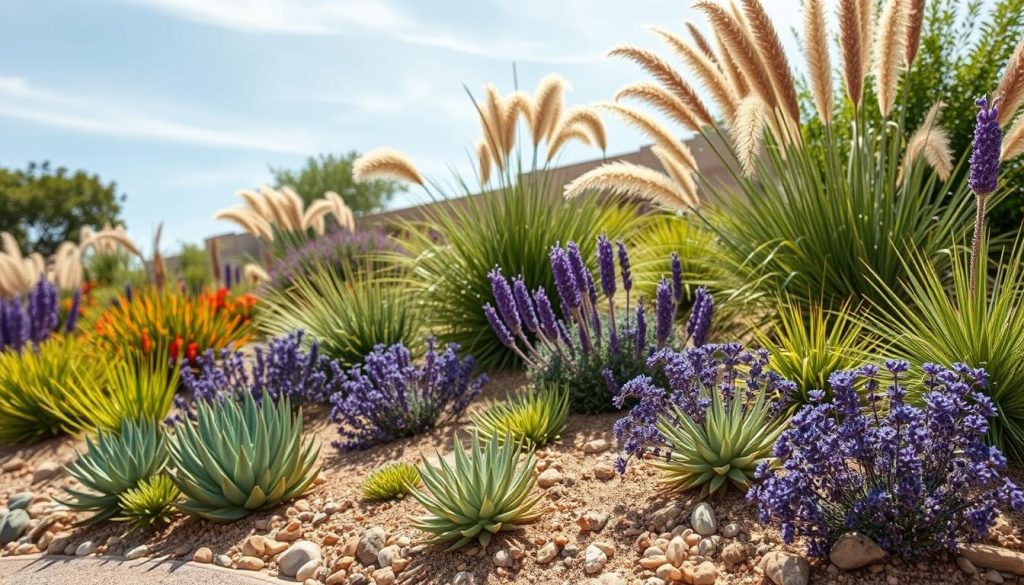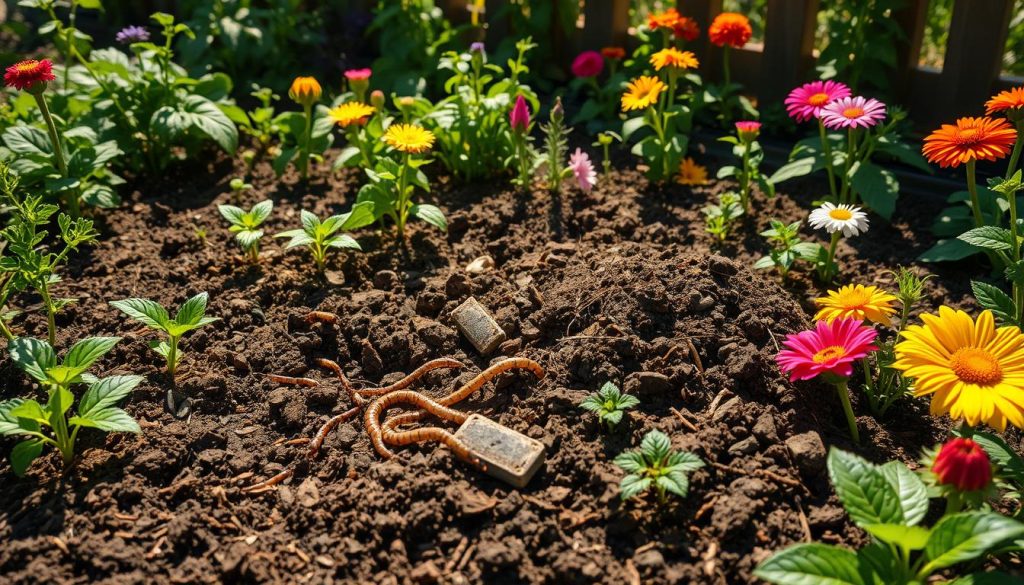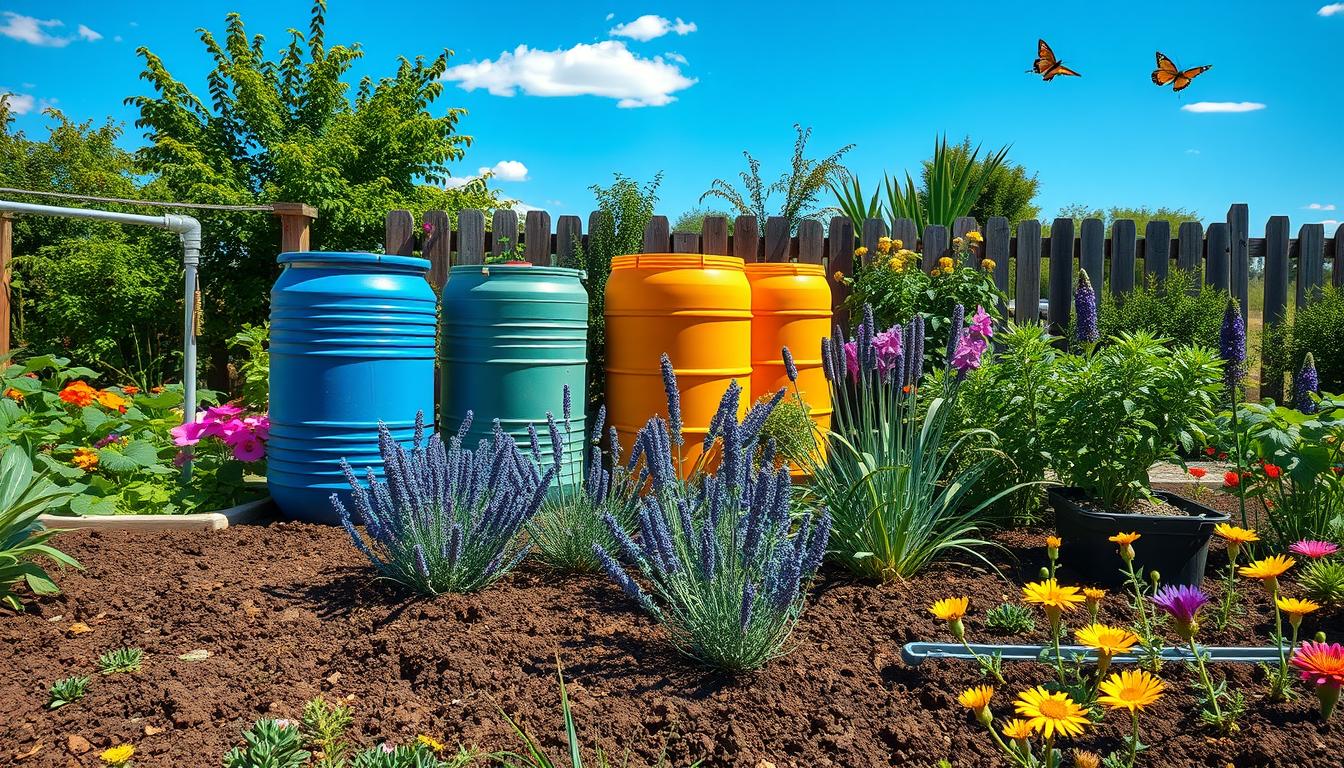As a gardener, I’ve learned that saving water is key for a beautiful garden. I’m excited to share my top tips with you. We’ll talk about choosing the right plants and efficient watering methods.
Using these tips, you’ll save water and have a stunning garden. I’ll show you how to reduce water use while keeping your garden healthy. It’s all about simple, eco-friendly practices.
These tips are for everyone, whether you’re new to gardening or have been doing it for years. They help you care for the environment while enjoying gardening. Let’s start making your garden more sustainable and water-efficient together.
Understanding the Importance of Water Conservation in Gardening
As a gardener, I’ve learned that saving water is key for the planet and my pocket. Using smart water-saving methods makes my garden more water-efficient. This helps keep my garden healthy and full of life.
Water-saving also cuts down on my water bills. I use systems that water plants just right and collect rainwater. This way, I use less water and help local water sources, especially when it’s dry.
Why Every Drop Counts
Every bit of water matters. Small changes in gardening can make a big difference. For instance, choosing plants that need less water and using mulch helps a lot. These steps make my garden beautiful and help the planet.

The Benefits of Water-Saving Practices
Water-saving practices offer many advantages:
- Lower water bills
- Bigger harvests
- Healthier soil
- Less erosion and runoff
- More water for everyone
By using these methods, my garden gets better and I help the environment. It’s a win-win for everyone.
| Water-Saving Practice | Benefits |
|---|---|
| Rainwater harvesting | Lower bills, more food |
| Drought-resistant plants | Less water, better soil |
| Mulching | Less erosion, better soil |
Selecting Native Plants for Your Garden
Choosing the right plants is key to saving water in your garden. Native plants are a great pick because they fit well with the local climate. They need less water, which is good for saving water and making your garden sustainable.
My top picks are succulents and wildflowers. They’re not only pretty but also need very little water. These plants are perfect for gardens that use smart watering methods. Adding them to your garden makes it beautiful and low-maintenance.
What Are Native Plants?
Native plants are those found naturally in a certain area. They’ve learned to thrive with less water and care. Choosing native plants makes your garden beautiful, sustainable, and good for the environment.
Benefits of Choosing Native Species
There are many good reasons to pick native plants for your garden. Some benefits include:
- Less water needed
- Less upkeep needed
- More biodiversity
- Better soil health
My Favorite Native Plants
Here are some of my favorite native plants:
- Succulents
- Wildflowers
- Grasses

Implementing Efficient Watering Techniques
As a gardener, I’ve found that using water wisely is key. It helps save water and keeps plants healthy. Drip irrigation systems are great because they water plants right at the roots. This cuts down on water lost to evaporation and runoff.
Timing is crucial when watering plants. Watering in the morning or evening helps save water. This is because it reduces evaporation. Here are some tips to help you water better:
- Use a drip irrigation system to deliver water directly to the roots of the plants
- Water in the early morning or evening to reduce evaporation
- Use a rain sensor to automatically adjust watering schedules based on weather conditions

By using these strategies, we can make our gardens more efficient and green. Every drop of water counts. By following these simple tips, we can really help save water.
Preparing Your Soil for Better Water Retention
As I share my tips on saving water in gardening, preparing your soil is key. This step is vital for using less water. By amending your soil and adding mulch, you can make it hold water better.
Adding compost or well-rotted manure can change your soil’s structure. This is great for gardens with sandy or clay soils. These soils drain fast or hold too much water. Organic matter helps make your soil more balanced and water-friendly.
Soil Amendments That Help
- Compost: rich in nutrients and helps improve soil structure
- Well-rotted manure: adds organic matter and improves water retention
- Peat moss: helps retain moisture and suppress weeds
The Role of Mulching
Mulching is also crucial for saving water in gardening. It reduces evaporation, keeps weeds away, and controls soil temperature. This makes watering more efficient, needing less frequent watering. Wood chips, straw, and grass clippings are good mulching choices.

By using these tips and practices, you can make your garden more sustainable. Choose the right soil amendments and mulch for your soil and climate. Don’t be afraid to try different things to see what works best for you.
| Soil Amendment | Benefits |
|---|---|
| Compost | Improves soil structure, increases nutrient content |
| Well-rotted manure | Adds organic matter, improves water retention |
| Peat moss | Retains moisture, suppresses weeds |
Creating a Rain Garden for Natural Irrigation
I’ve found that rain gardens are a great way to save water in my garden. They are shallow depressions that catch and filter rainwater. This reduces the need for irrigation and makes my garden more sustainable.
Creating a rain garden helps me use less water. Here are some benefits:
- Reduced stormwater runoff
- Improved water quality
- Increased biodiversity
- Lower water bills
To design a rain garden, I look at my yard’s slope and drainage. I also choose plants that do well in rainwater. This way, I make my garden beautiful and eco-friendly.
Designing a Rain Garden
Designing a rain garden requires careful planning. It should be in a low spot where water collects. The size should match the local rainfall. By following these steps, I can make a rain garden that saves water and helps wildlife.
Using Containers and Raised Beds Wisely
I’ve found that using containers and raised beds is great for a water-efficient garden. They’re perfect for small spaces, allowing plants to grow well while saving water. By choosing drought-resistant plants and smart watering, my garden thrives with less effort.
Container gardening lets me control soil and water better. This is key for plants that don’t like too much water. Succulents and cacti are my go-to for containers, as they need careful watering to do well.
Benefits of Container Gardening
Container gardening has many perks:
- Improved soil quality and drainage
- Increased control over watering and fertilization
- Reduced soil erosion and compaction
- Enhanced aesthetic appeal
Choosing the Right Containers
When picking containers, I look at size, material, and drainage. It’s important to choose big enough containers with good drainage holes. This way, I can keep my garden healthy with minimal upkeep.
Mastering the Art of Composting
Exploring garden tips, I found composting key for reducing waste and enriching soil. Adding compost helps water stay in the soil longer. This cuts down on the need for fertilizers, aiding in water conservation.
Composting is easy to do at home. It helps us reduce our environmental impact. Start by collecting kitchen scraps, leaves, and other organic stuff. Put them in a compost bin. It’s important to mix “green” stuff like food scraps with “brown” stuff like leaves for a good compost pile.
How Composting Aids Water Conservation
Composting helps save water by making soil better at holding water. This means plants need less water, cutting down on watering and runoff. Plus, compost filters out pollutants and sediments from water, helping our gardens use water wisely.
My Easy Composting Tips
To make composting simple, follow these tips:
- Start small and add more materials slowly
- Keep a mix of green and brown materials
- Turn the compost pile often for better aeration and faster breakdown
- Use the finished compost to improve soil and its water-holding ability
By using these tips and adding composting to our garden care, we can make our gardens more sustainable and eco-friendly.
Planning Your Garden Layout Smartly
Planning your garden layout is key for saving water. Arranging plants to grow well and use less water makes your garden more efficient. Eco-friendly gardening practices help you use your garden’s full potential.
Start with companion planting. This means pairing plants that grow well together and need less water. For example, marigolds with tomatoes can keep pests away, saving water and soil health.
The Concept of Companion Planting
Companion planting makes your garden better by pairing plants that help each other. This can include basil with lettuce, beans with corn, and radishes with cucumbers. These combinations create a healthy garden ecosystem.
Grouping Water-Dependent Plants
Grouping plants that need a lot of water together helps you water smarter. This saves water and makes sure each plant gets enough moisture. Use drip irrigation to water plants like tomatoes and squash directly at their roots.
Using these eco-friendly gardening tips, you can make a beautiful, water-saving garden. It will also help your plants grow healthy and support biodiversity. Be ready to change your garden layout as needed, based on your climate, soil, and plants.
Maintaining Your Garden Efficiently
To keep our garden thriving while saving water, we must focus on sustainable water management. This means using practices that cut down on water waste. It helps us create a garden that saves water and needs less care.
Regular Maintenance Tasks
Some regular tasks can help save water in our garden. These include:
- Checking the irrigation system for leaks and damage
- Watering plants during the early morning or evening to minimize evaporation
- Mulching around plants to retain moisture in the soil
These simple steps can greatly reduce water waste. They help us manage water more sustainably in our garden.
Winterizing Your Garden
Winterizing our garden is key for saving water and keeping it healthy. We can do this by:
- Draining and storing irrigation systems to prevent damage from freezing temperatures
- Applying a layer of mulch to protect the soil from extreme temperatures
- Planting drought-tolerant species that require less water during the winter months
By following these tips, our garden stays healthy and water-efficient during winter.
| Season | Maintenance Tasks | Water Conservation Tips |
|---|---|---|
| Spring | Check irrigation system, prune plants | Water plants during early morning or evening |
| Summer | Mulch around plants, monitor soil moisture | Use drought-tolerant plants, avoid overwatering |
| Autumn | Drain irrigation system, apply mulch | Harvest rainwater, use efficient irrigation systems |
| Winter | Store irrigation system, protect soil | Use covers to retain moisture, avoid overwatering |
Exploring Eco-Friendly Gardening Alternatives
As we finish talking about saving water in gardens, let’s look at green options. Choosing between organic and chemical fertilizers is key. Organic fertilizers like compost help plants and improve soil. Chemicals can harm soil and water.
Organic Fertilizers vs. Chemical
I choose organic fertilizers for my garden. They’re good for the planet and make plants healthier. Using compost helps my soil and saves water for my plants.
Using Greywater and Its Benefits
I also use greywater, which is clean water from sinks and washing machines. It saves a lot of water. Greywater irrigation gives soil nutrients, cutting down on fertilizer needs.
These green gardening choices make my garden sustainable and water-efficient. It’s great for my plants and the planet.

